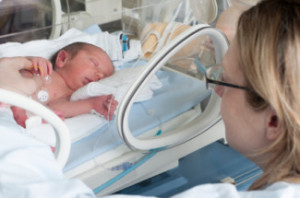Preventing Infant Hypoxic-Ischemic Encephalopathy with Hypothermia Treatment
 Researchers from the Children’s Hospital of Los Angeles (CHLA) have confirmed the protective benefits of hypothermia treatment on newborns with Hypoxic-Ischemic Encephalopathy (HIE). Hypoxic-Ischemic Encephalopathy (HIE) – a result of birth asphyxia — occurs when the fetal brain does not receive adequate oxygen. Without swift treatment, newborns with HIE may go on to suffer from permanent brain damage, developmental problems and cerebral palsy. An estimated one million babies are left disabled and another one million die from HIE worldwide, according to statistics.
Researchers from the Children’s Hospital of Los Angeles (CHLA) have confirmed the protective benefits of hypothermia treatment on newborns with Hypoxic-Ischemic Encephalopathy (HIE). Hypoxic-Ischemic Encephalopathy (HIE) – a result of birth asphyxia — occurs when the fetal brain does not receive adequate oxygen. Without swift treatment, newborns with HIE may go on to suffer from permanent brain damage, developmental problems and cerebral palsy. An estimated one million babies are left disabled and another one million die from HIE worldwide, according to statistics.
CHLA researchers sought to uncover the biomechanics of brain activity during hypothermia treatment to help them hone their methods for newborns that are most likely to benefit from brain cooling therapy.
“Although we know hypothermia helps, we don’t fully understand how it helps or how best to help those babies for whom hypothermia isn’t enough to alleviate their brain injury,” explained Jessica Wisnowski, PhD, one of the study’s main authors.
According to Wisnowski, hypothermia treatment isn’t effective at mitigating brain injury in approximately 50 percent of newborns with HIE.
Hypothermia slows down brain metabolism
Brain trauma from oxygen deprivation is an evolving process that becomes evident as mitochondria within the brain cells are disrupted. Since this process can take weeks to fully evolve, physicians have an opportunity to intervene with controlled hypothermia in an effort to save brain cells. Hypothermia functions to slow down the brain’s metabolism, giving it a chance to repair damaged cells.
Through their research, Wisnowski and colleagues suggested that a notable result of hypothermia is not only a slowed metabolism, but also a reduction in the production of excitatory neurotransmitters such as glutamate. These findings were based on precise measurements (using conducted magnetic resonance spectroscopy) of key molecules used in energy storage, neurotransmission and oxidative stress in 31 babies with HIE.
The team found that hypothermia decreases excitatory transmitters, which in turn may reduce the chance of seizures. Based on these findings, doctors may be able to take a more customized approach to therapeutic hypothermia for newborns who suffered birth asphyxia, with an eye to reducing chances of long-term brain damage.
HIE-related birth injuries
While HIE can result from any number of labor and delivery complications that result in limited oxygen flow to the baby, there are certain instances which may be attributed to medical errors or lapses in judgement on the part of delivery room staff.
Health care professionals are obligated to provide a certain standard of care to both mother and child, and in the context of medical malpractice, may be held accountable for birth trauma and HIE that was preventable.
Below are some possible causes of birth asphyxia:
- Placental abruption
- Ruptured uterus
- Umbilical cord complications/prolapse
- Premature birth
- Untreated eclampsia
- Fetal stroke
- Fetal distress
- Pitocin-induced hyperstimulation
- Failure to perform emergency C-section
Obstetric emergencies necessitate prompt action to help prevent unnecessary birth injury. If a nurse, doctor or midwife fails to act in a swift and competent manner when signs of fetal distress or demise are evident, this may constitute negligence and provide grounds for medical malpractice litigation.
- Science20.com, Protecting Newborn Brains From Hypoxic-Ischemic Encephalopathy Using Hypothermia http://www.science20.com/news_articles/protecting_newborn_brains_from_hypoxicischemic_encephalopathy_using_hypothermia-157432
- Journal of Clinical Neonatalogy, Whole Body Cooling for Infants with Hypoxic-Ischemic Encephalopathy http://www.ncbi.nlm.nih.gov/pmc/articles/PMC3743149/

 Resources
Resources
 Resources
Resources

